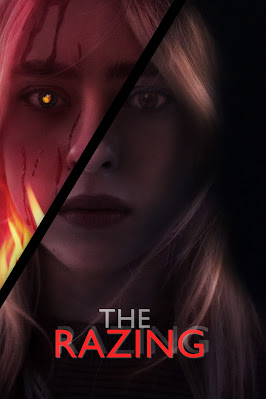Text © Richard
Gary / Indie Horror Films, 2022
Images from the Internet
The Razing
Directed by J. Arcane and Paul Erskine
Pacific Future Films
109 minutes, 2022
When I get together with a bunch of friends that I haven’t seen in a long time, even if we didn’t necessarily leave on the best of terms, it almost always turns into a night of joy, and maybe a titch of resentment here and there, but we tend to work it out, even if we agree never to talk again. But in the cinematic world, that only works out in the Hallmark type films, and usually involves either Thanksgiving or especially Christmas, but never in genre films. And this belongs to the latter. It’s in the title, which means “the complete tearing down.” Heck, the film’s tag line is ”burn, baby, burn.” Before I even start, the description reminds me a bit of Who’s Afraid of Virginia Woolf? (1966).
For Cory’s birthday dinner, there are four old friends plus the guest of one of them, so two women and four men. There is animosity and tension present right from the start; no waiting around, no pretending, the story just dives right in and takes the viewer with them.
I love it when a title can be taken in different contexts. The obvious one is that these people don’t like each other, and are willing to verbally tear each other down. Jealousy, lust, and power all factor into not only the old “friends,” but even the new arrivals. But this group is sort of like Prospero in Edgar Allen Poe’s short story, “The Masque of the Red Death,” as there is something possibly evil happening beyond the walls, that is making people violent, such as in the likes of The Crazies (1973; 2010). But this can also be seen as a metaphor for other pandemics (COVID, anyone?), with some at the table not even believing it’s a real thing as people are murdering others beyond the viewer’s scope of the film. In fact, except for one scene, the entire film takes place in the spacious apartment.
The main characters are an unlikeable crew in their thirties who have carried around their overstuffed baggage since they were college age. The main troupe is bearded and bespecled Cory (Jack Wooten), who is as verbally abusive as his wealthy father (Kent Allen); his spouse is Ellen (Laura Sampson Hemingway), who everyone seems to desire; then there is Ray (Logan Paul Prince), who looks a bit like a jock and has the hots for Ellen (or “El”, as she’s often called), even though he brought along a guest in the form of Claire (Mia Heavner); then there’s Lincoln (Nicholas Tene), who, as a child, was raised by a then college student and then badly drunk “mom” (Kim Allison Hèbert). Lincoln’s friend when he was younger, Josh (Jay Torres), did not fare well with this group; hopefully, Claire will do better.
What both holds the collective together and tears them apart is a combination of drugs in the form of pills, and an event that we see in great detail in the past when they were young, told in extensive flashbacks in the same apartment.
The question the film leaves the viewer with is: what is truth. How many of the events depicted are “real” and how many are hallucinations by the many, many, pills of various colors that are ingested in the 109 minutes of the film? Are the supernatural elements real, or are they mind games played by chemical infusions?
In many ways this can be considered an art film, or even fall under the Transgressive Cinema label. Angles are off-putting, with a tendency to extreme close-ups (not always in focus), pointed at an upward angle, or hand-held and swirling a bit. Visually, the screen often looks dark, like it’s in power-saver mode and with a yellowish filter, with occasional effective use of split screens, and the vocals appear to be flat and dubbed in; there is no depth so everyone seems to be at the same distance even if they are at the opposite sides of the room. Even the orchestral soundtrack, written by co-director J. Arcane, is moody, spiky and dissonant, which actually works well for the piece, though it’s a bit more upfront than needs to be, so it occasionally is distracting to the talking, and dialogue is key in this film.
Being filmed during the time of COVID, it is interesting to see how everything on-screen is designed and the large apartment space is used in the shots, with fish-lenses used to disrupt the visual space and keeping people looking closer than they actually are. That is not to say there isn’t any touching, because there is, but it’s minimal, albeit intense.
Along with the visuals, philosophically the film delves into society, class relations, and the possibility of redemption, as well as a bit of insanity. When does one’s life become too much? At nearly two hours, it feels a bit long, honestly, and it tries hard to be meaningful. Perhaps a second viewing at some point will bring home some of the points I may have missed. It’s a very lulling film that is certainly consistent with its own “feel,” sound, and intensity.
This is the first release for Pacific Future Films, and it’s a good freshman step in the right direction. I’m really curious to see where they go from here.
IMBD Listing HERE
Vimeo trailer HERE

No comments:
Post a Comment